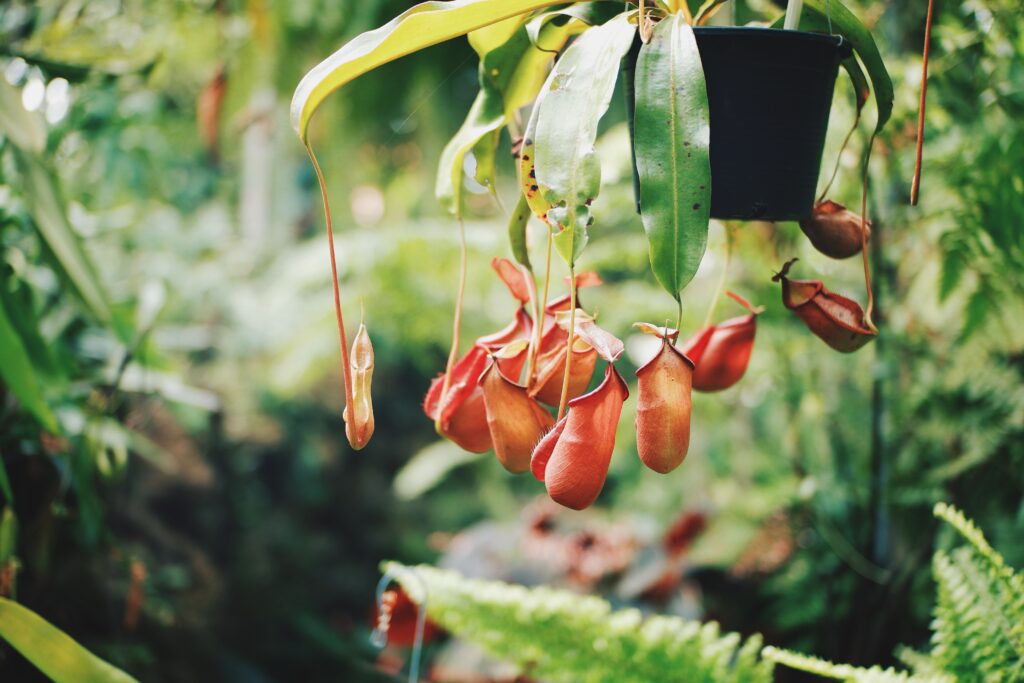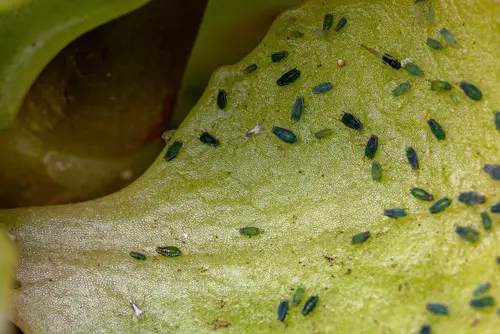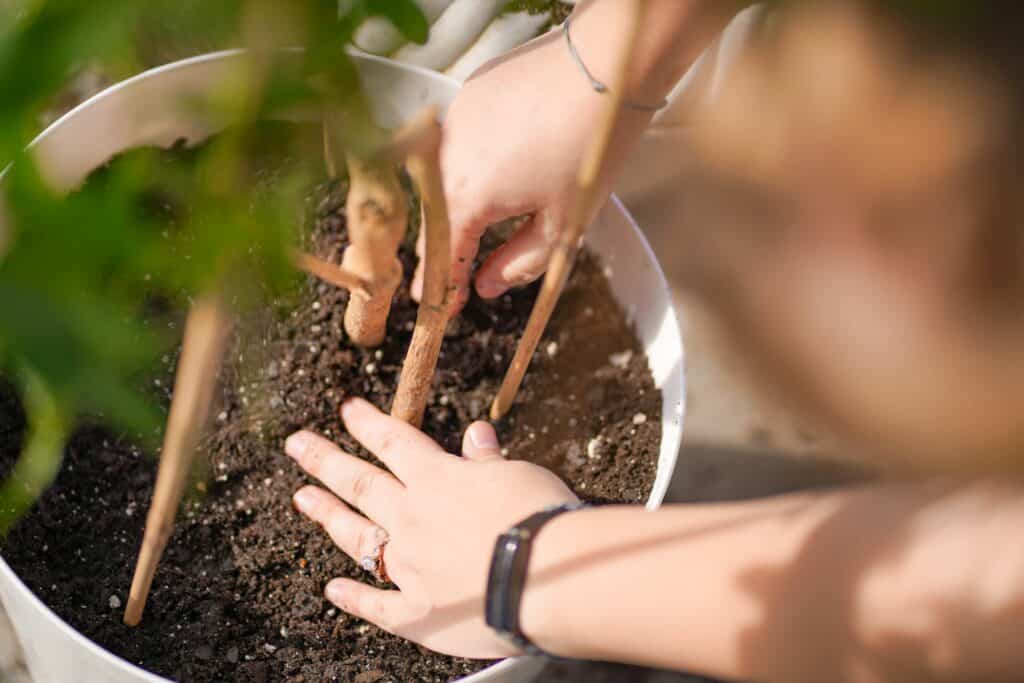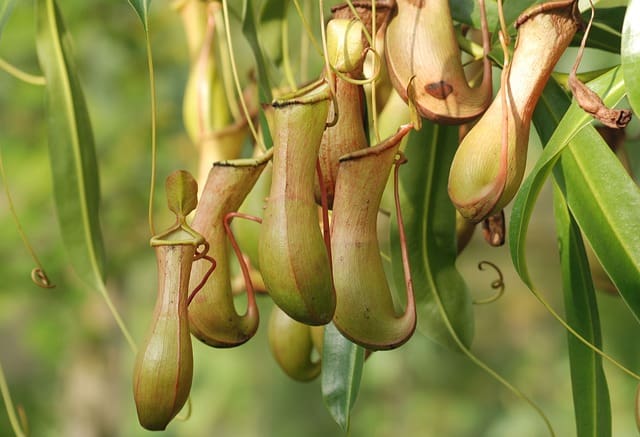Nepenthes, commonly known as pitcher plants, are fascinating carnivorous plants that are known for their unique and striking appearance. However, if you notice your Nepenthes leaves turning brown, it can be a cause for concern. Brown leaves can be an indication of several issues that need immediate attention.
Understanding Nepenthes is crucial to identifying the symptoms of brown leaves. These plants are native to tropical regions, and their habitat includes humid and warm environments.
They require specific growing conditions to thrive, and any deviation from these requirements can cause stress to the plant. Brown leaves are a sign that something is wrong, and it’s essential to identify the root cause of the problem to take appropriate action.
Key Takeaways on Nepenthes Leaves Turning Brown
- Brown leaves on Nepenthes can indicate several issues that need attention.
- Understanding Nepenthes and its specific needs is crucial to identifying the root cause of the problem.
- Addressing topics such as light, water, humidity, soil, pests, and diseases can help keep Nepenthes healthy.
Also don’t miss:
Understanding Nepenthes

Nepenthes, also known as tropical pitcher plants or monkey cups, are a type of carnivorous plant that are native to Southeast Asia, Madagascar, and Australia. They are known for their unique pitcher-shaped traps that lure in insects and other small prey.
The traps are modified leaves that have evolved to become slippery and contain a digestive fluid that breaks down the prey. Nepenthes plants are typically grown in warm, humid environments and require bright, indirect light to thrive.
There are over 170 species of Nepenthes, each with their own unique characteristics and growing requirements. Some species grow as vines, while others grow as rosettes. Some species produce large, showy pitchers, while others produce smaller, more inconspicuous ones.
Despite their unique appearance and carnivorous nature, Nepenthes are relatively easy to care for. As long as they are provided with the right growing conditions, they can be a rewarding addition to any plant collection.
However, Nepenthes plants are not without their problems. One common issue that growers face is brown leaves. Brown leaves on a Nepenthes plant can indicate a variety of problems, including overwatering, underwatering, insufficient humidity, too much direct sunlight, pest infestations, or fungal/bacterial infections.
It is important to identify the underlying cause of the problem in order to take appropriate action.
Symptoms of Brown Leaves
Nepenthes leaves turning brown is a common issue that many growers face. Brown leaves are a sign that something is not right with the plant. It could be due to a variety of reasons, such as overwatering, underwatering, nutrient deficiencies, or pests. Here are some symptoms of brown leaves that growers should look out for:
1. Dried Out Leaves
One of the most common symptoms of brown leaves is that they become dry and brittle. This happens when the plant is not getting enough water.
The leaves will start to curl up and turn brown, and if the problem persists, they will eventually die. Growers should make sure that they are watering their Nepenthes plant adequately and not letting the soil dry out completely.
2. Brown Spots on Leaves
Another symptom of brown leaves is the appearance of brown spots on the leaves. This is usually a sign of a fungal or bacterial infection. The spots will start out small and gradually get bigger, and the affected leaves may eventually die. Growers should remove any infected leaves and treat the plant with a fungicide or bactericide.
3. Wilting Leaves
Wilting leaves are another symptom of brown leaves. This happens when the plant is not getting enough water or is getting too much water.
The leaves will start to droop and turn brown, and if the problem persists, they will eventually die. Growers should make sure that they are watering their Nepenthes plant adequately and not overwatering.
4. Brown and Dying Leaves
If the leaves on a Nepenthes plant are turning brown and dying, it could be due to a nutrient deficiency. The plant may not be getting enough of certain nutrients, such as magnesium or nitrogen. Growers should make sure that they are providing their plant with a balanced fertilizer that contains all the necessary nutrients.
Role of Light and Heat

Nepenthes pitcher plants require a specific amount of light and heat to thrive. However, too much or too little of either can cause the leaves to turn brown.
Direct sunlight can be harmful to Nepenthes plants, especially during the hottest part of the day. The intense heat and UV rays can cause heat stress and damage the leaves, leading to brown spots or burnt edges. It is recommended to provide shade during the hottest part of the day or move the plant to a location with indirect sunlight.
On the other hand, insufficient light can also cause brown leaves. Nepenthes plants require bright, indirect light to photosynthesize and produce energy. If the plant is not receiving enough light, it may not be able to produce enough energy to maintain healthy leaves, leading to brown or yellowing leaves.
It is important to find a balance between light and shade to prevent brown leaves. A good rule of thumb is to provide bright, indirect light for 6-8 hours a day, and shade during the hottest part of the day.
In addition to light, heat can also play a role in brown leaves. Nepenthes plants prefer warm temperatures between 70-85°F (21-29°C). If the plant is exposed to temperatures outside of this range, it may experience heat stress and cause brown leaves.
| Light | Heat |
| Direct sunlight can cause heat stress and damage the leaves | Nepenthes plants prefer warm temperatures between 70-85°F (21-29°C) |
| Insufficient light can also cause brown leaves | Exposure to temperatures outside of the preferred range can cause heat stress and brown leaves |
| Bright, indirect light for 6-8 hours a day is recommended | Monitor the temperature and provide consistent warmth |
Watering Practices
Nepenthes plants require a consistent level of moisture to thrive. However, over-watering or under-watering can cause the leaves to turn brown and eventually die. It is important to establish a watering routine that provides the plant with the right amount of water.
When it comes to watering Nepenthes plants, there are a few things to keep in mind. First, it is important to use the right type of water. Rainwater or distilled water is preferred over tap water, as tap water may contain minerals and chemicals that can harm the plant.
Second, it is important to avoid waterlogging. Waterlogging occurs when the soil is consistently saturated with water, which can lead to root rot and other problems. To prevent waterlogging, it is important to ensure that the soil has proper drainage and that excess water is able to drain away.
Third, it is important to avoid under-watering. Nepenthes plants require a consistent level of moisture, so it is important to water them regularly. However, it is important to avoid over-watering as well, as this can lead to waterlogging and other problems.
To establish a watering routine, it is recommended to water the plant once a week. However, the frequency of watering may vary depending on factors such as the climate, humidity levels, and the type of soil. It is important to monitor the soil moisture level and adjust the watering routine accordingly.
Humidity Requirements

Nepenthes plants require high humidity levels to thrive. In general, the ideal humidity range for these plants is between 75% and 100%. However, the optimal humidity level may vary depending on the specific species of Nepenthes and its growing conditions.
Highland Nepenthes species grow above 3000 feet in the mountains, where humidity levels are typically high. These plants require a humidity level of around 75% during the day and 100% at night.
On the other hand, lowland Nepenthes species grow in open areas such as forests and fields, where humidity levels may be lower. These plants require a humidity level of around 80-90% during the day and 100% at night.
To maintain the required humidity level, it is important to keep the soil moist and provide adequate water to the plant. Additionally, using a humidifier or placing the plant in a tray filled with water can help increase the humidity level around the plant.
It is important to note that excessive humidity levels can also be detrimental to Nepenthes plants. High humidity combined with low air circulation can lead to the growth of mold and other fungal diseases. Therefore, it is important to maintain a balance between humidity and air circulation to ensure the plant’s health.
In summary, Nepenthes plants require high humidity levels to thrive, with the ideal range between 75% and 100%. Highland and lowland species may have slightly different humidity requirements.
To maintain the required humidity level, it is important to keep the soil moist, provide adequate water to the plant, and use a humidifier or tray of water. However, excessive humidity levels can also be harmful, so it is important to maintain a balance between humidity and air circulation.
Soil and Drainage
The right soil mix and proper drainage are crucial for Nepenthes plants to thrive. The wrong soil mix or poor drainage can cause the leaves to turn brown and dry out.
Nepenthes plants require a well-draining soil mix that retains moisture without becoming waterlogged. A mix of sphagnum moss, perlite, and orchid bark is an excellent option. This mix provides good drainage while retaining the necessary moisture levels.
Using the wrong soil mix can cause Nepenthes leaves to turn brown. Avoid using garden soil or standard potting soil, as they do not provide adequate drainage. Instead, opt for a soil mix specifically formulated for carnivorous plants.
In addition to the right soil mix, proper drainage is essential. Nepenthes plants do not tolerate standing water, so it’s crucial to ensure that the pot has drainage holes. Placing a layer of sand or pebbles at the bottom of the pot can also help improve drainage.
Overwatering and underwatering can also cause Nepenthes leaves to turn brown. It’s essential to allow the top inch of soil to dry out before watering again. Reduce watering if necessary, as underwatering can also cause leaves to turn brown and dry out.
Pest and Disease Management

Nepenthes plants can be susceptible to pest infestations, such as mealybugs, aphids, thrips, and scale, which can cause leaves to turn brown. Inspect the plant regularly for signs of pests, such as sticky residue, webbing, or visible insects, and treat with an appropriate insecticide or soap solution.
When treating pests, it is important to use a product that is safe for Nepenthes plants and follow the instructions carefully. Some insecticides may harm the plant or its sensitive roots if used improperly.
In addition to pests, Nepenthes plants may also be susceptible to fungal or bacterial diseases, which can cause brown spots or discoloration on the leaves. To prevent disease, it is important to maintain good hygiene by removing dead or decaying plant material and avoiding overwatering or overcrowding.
If disease does occur, it may be necessary to treat with a fungicide or bactericide. Again, it is important to choose a product that is safe for Nepenthes plants and follow the instructions carefully.
Regular monitoring and proper pest and disease management can help keep Nepenthes plants healthy and prevent leaves from turning brown.
Feeding and Nutrient Needs
Nepenthes plants are carnivorous, and they obtain most of their nutrients from insects, ants, and other prey that they trap in their pitchers. However, they still require some essential nutrients to maintain healthy growth and prevent their leaves from turning brown.
One of the most important nutrients for Nepenthes plants is magnesium. If a Nepenthes plant is not receiving enough magnesium, its leaves will begin to turn brown.
To prevent this, it is important to feed Nepenthes plants with a fertilizer that contains magnesium. A balanced fertilizer with an NPK ratio of 10-10-10 or 20-20-20 can provide the necessary nutrients, including magnesium.
It is also important to note that Nepenthes plants are sensitive to overfeeding, so it is recommended to use a diluted fertilizer solution and feed the plant once a month during the growing season. During the dormant season, it is best to avoid feeding altogether.
In addition to magnesium, Nepenthes plants also require other essential minerals and trace elements, such as nitrogen, phosphorus, potassium, iron, and calcium. These nutrients can be obtained from a balanced fertilizer or by using a specialized carnivorous plant fertilizer.
It is important to avoid using tap water to feed Nepenthes plants, as the high mineral content can harm the plant. Instead, it is recommended to use rainwater, distilled water, or reverse osmosis water. These types of water are low in minerals and will not cause any harm to the plant.
Repotting and Care

Nepenthes plants require proper care to prevent their leaves from turning brown. Repotting is an essential part of caring for Nepenthes plants, as it ensures that the plant has enough space to grow and thrive.
When repotting, it is important to choose a pot that is the right size for the plant. If the pot is too small, the plant may become root-bound, which can lead to stunted growth and poor health.
When repotting, it is also important to use the right type of soil. Nepenthes plants require well-draining soil that is rich in nutrients. A mixture of sphagnum moss, perlite, and orchid bark is ideal for Nepenthes plants. This type of soil allows for proper drainage while also providing the plant with the nutrients it needs to grow.
To repot a Nepenthes plant, gently remove it from its current pot and carefully remove any old soil from the roots. Trim any dead or damaged roots, and then place the plant in its new pot with fresh soil. Water the plant thoroughly after repotting to help it settle into its new home.
In addition to proper repotting, there are other steps that can be taken to keep Nepenthes plants in good condition. It is important to keep the plant in a location that receives bright, indirect light. Direct sunlight can cause the leaves to turn red or yellow, while too little light can cause the leaves to become dark and green.
Regularly removing dead or dying leaves can also help to keep Nepenthes plants in good condition. This can be done by cutting off the affected leaves at the base of the stem. Additionally, removing side shoots can help to direct the plant’s energy towards producing new pitchers.
Specific Needs of Highland and Lowland Species
Nepenthes plants are divided into two species groups – highland and lowland. Highland species grow at higher altitudes and require cooler temperatures, while lowland species grow at lower altitudes and require warmer temperatures.
Understanding the specific needs of each species group is crucial to keeping your Nepenthes healthy and thriving.
1. Highland Species
Highland species, such as Nepenthes Villosa, require cooler temperatures and a temperature gradient between day and night. During the day, the temperature should be between 70-80°F (21-27°C), while at night, the temperature should drop to around 55-60°F (13-16°C).
Highland species also require high humidity levels, ideally between 70-80%.
In terms of lighting, highland species require bright, indirect light. Direct sunlight can scorch their leaves and cause them to turn brown or yellow. If you notice your highland Nepenthes turning brown, it may be due to too much direct sunlight.
2. Lowland Species
Lowland species, such as Nepenthes Alata, require warmer temperatures and high humidity levels. During the day, the temperature should be between 75-85°F (24-29°C), with a nighttime temperature of around 70°F (21°C). Lowland species also require high humidity levels, ideally between 70-80%.
In terms of lighting, lowland species require bright, direct light. They can tolerate more sunlight than highland species, but too much direct sunlight can still cause their leaves to turn brown or yellow.
3. Winter Care
During the winter months, it’s important to adjust your Nepenthes care routine to account for the cooler temperatures. Highland species may require additional heating to maintain the ideal temperature gradient, while lowland species may require additional humidity to combat dry winter air.
Unique Challenges of Indoor and Terrarium Growing

Growing Nepenthes indoors or in a terrarium can present unique challenges that are not encountered in outdoor growing. In this section, we will discuss some of the common challenges faced by indoor and terrarium growers.
1. Limited Sunlight
One of the biggest challenges for indoor and terrarium growers is providing adequate sunlight. Nepenthes require bright, indirect sunlight to thrive. However, many indoor environments do not provide enough sunlight to meet the plant’s needs. Growers may need to supplement with artificial lighting to provide the necessary light for the plant to grow.
2. Limited Airflow
Another challenge of indoor and terrarium growing is limited airflow. Nepenthes require good air circulation to prevent the growth of mold and other harmful organisms.
In a closed terrarium or indoor environment, air circulation may be limited, which can lead to problems. Growers may need to use fans or other methods to increase airflow and prevent the growth of harmful organisms.
3. Limited Lifespan
Nepenthes have a limited lifespan, and indoor and terrarium growing can shorten their lifespan even further. The limited space and resources of indoor and terrarium growing can cause the plant to become stressed, which can lead to a shorter lifespan.
Growers should be aware of the plant’s lifespan and take steps to ensure that the plant is healthy and thriving for as long as possible.
4. Window Placement
For indoor growers, window placement is critical. Nepenthes require bright, indirect sunlight, and the placement of the window can affect the amount of light the plant receives.
A window facing north may not provide enough light, while a window facing south may provide too much light. Growers should experiment with different window placements to find the optimal location for their Nepenthes.
5. Terrariums
Terrariums can be a great way to grow Nepenthes indoors, but they can also present challenges. Terrariums can trap heat and moisture, which can lead to the growth of harmful organisms. Growers should choose a terrarium that provides adequate ventilation and drainage to prevent the growth of harmful organisms.
Dealing with Affected Leaves

If you notice that your Nepenthes leaves are turning brown and drying out, there are a few steps you can take to deal with the issue.
Firstly, if the affected leaves are still attached to the plant, it is best to leave them alone. This is because the plant can still extract nutrients from the dying leaves. However, if the leaves have already dried out and fallen off, they can be carefully removed from the plant.
To prevent further drying out of the leaves, it is important to ensure that the plant is getting enough water. This can be achieved by watering the plant regularly and ensuring that the soil is consistently moist, but not waterlogged. If the plant is not getting enough water, the leaves can turn brown and dry out.
It is also important to ensure that the Nepenthes plant is getting enough humidity. These plants require high humidity levels to thrive, and brown leaves can indicate that the plant is not receiving enough moisture. To increase humidity levels, consider using a humidifier or placing a tray of water near the plant.
In addition to water and humidity, it is important to ensure that the Nepenthes plant is getting enough nutrients. This can be achieved by fertilizing the plant regularly with a balanced fertilizer. However, it is important to avoid over-fertilizing the plant, as this can also cause the leaves to turn brown and dry out.
Overall, dealing with affected leaves on a Nepenthes plant involves ensuring that the plant is getting enough water, humidity, and nutrients. By taking these steps, you can help to prevent further drying out of the leaves and promote healthy growth of the plant.
Propagation of Nepenthes
Nepenthes can be propagated in two ways: by seed or by cuttings. Propagation by seed is the most common method, but it can take a long time to grow a mature plant. Propagation by cuttings is faster, but it requires more skill and experience.
Propagation by Seed
Propagation by seed is the most common method of propagating Nepenthes. Seeds can be collected from mature plants or purchased from a reputable supplier. Fresh seeds are more likely to germinate than older seeds, so it is important to use fresh seeds.
To propagate Nepenthes by seed, the seeds must be sown in a suitable growing medium. A mixture of sphagnum moss and perlite is a good choice. The seeds should be sown on the surface of the medium and covered with a thin layer of sphagnum moss. The container should be covered with a clear plastic bag to maintain humidity.
The seeds should be kept in a warm, bright location, but not in direct sunlight. The growing medium should be kept moist but not waterlogged. Germination can take several weeks to several months, depending on the species.
Propagation by Cuttings
Propagation by cuttings is a faster method of propagating Nepenthes, but it requires more skill and experience. Cuttings should be taken from healthy, young leaves, and the cuts should be made just below the leaf node. The cuttings can be rooted in a mixture of sphagnum moss and perlite or in water.
To root cuttings in a mixture of sphagnum moss and perlite, the cuttings should be inserted into the medium and covered with a clear plastic bag to maintain humidity. The container should be kept in a warm, bright location, but not in direct sunlight. The growing medium should be kept moist but not waterlogged.
To root cuttings in water, the cuttings should be placed in a container of water and covered with a clear plastic bag to maintain humidity. The container should be kept in a warm, bright location, but not in direct sunlight. The water should be changed every few days to prevent stagnation.
Propagation by cuttings can be more successful if the cuttings are treated with a rooting hormone before planting. Rooting hormone can be purchased from a garden center or online retailer.
Propagation by cuttings can also be used to rejuvenate an old or leggy Nepenthes plant. By taking cuttings from the top of the plant and rooting them, the plant can be made more compact and bushy.
Nepenthes in Different Regions

Nepenthes, also known as tropical pitcher plants, are native to Southeast Asia, Australia, and Madagascar. They are found in a variety of habitats including lowland forests, montane forests, and even in disturbed areas such as roadsides and abandoned agricultural land.
In their natural habitat, Nepenthes are adapted to the specific conditions of their region. For example, Nepenthes found in lowland forests require high humidity and warm temperatures, while those found in montane forests require cooler temperatures and lower humidity.
In Australia, Nepenthes are found in the tropical north, where they grow in the rainforest and other moist habitats. The species found in Australia are unique in their ability to tolerate and even require fire to regenerate.
This is because fires are a natural occurrence in the Australian savanna and rainforest, and Nepenthes have adapted to this by developing thick underground rhizomes that allow them to survive fires.
In addition to their adaptations to specific regions, Nepenthes also have variations in their morphology. For example, Nepenthes found in lowland forests tend to have larger pitchers with more colorful patterns to attract insects, while those found in montane forests tend to have smaller pitchers with less conspicuous patterns.
Frequently Asked Questions
What causes brown spots on pitcher plant leaves?
Brown spots on pitcher plant leaves can be caused by a variety of factors, including fungal or bacterial infections, insect infestations, or physical damage. To prevent brown spots, make sure to provide adequate air circulation, avoid overwatering, and keep the plant free from pests.
Why are my Nepenthes leaves turning yellow and brown?
Nepenthes leaves turning yellow and brown can be a sign of nutrient deficiencies, overwatering, or pests. To prevent this, make sure to provide the plant with the proper amount of light, water, and nutrients, and keep it free from pests.
Why is my pitcher plant pitchers turning brown?
Pitcher plant pitchers turning brown can be a sign of old age, disease, or insect infestations. To prevent this, make sure to provide the plant with the proper care, including adequate water and nutrients, and keep it free from pests.
Why are the new leaves on my Nepenthes turning black?
New leaves on Nepenthes turning black can be a sign of fungal or bacterial infections, overwatering, or nutrient deficiencies. To prevent this, make sure to provide the plant with the proper care, including adequate water and nutrients, and keep it free from pests.
What does an overwatered pitcher plant look like?
An overwatered pitcher plant may have yellow leaves, brown spots, or wilted leaves. To prevent overwatering, make sure to allow the soil to dry out between waterings and avoid watering the plant too frequently.
Why is my pitcher plant turning black?
A pitcher plant turning black can be a sign of old age, disease, or insect infestations. To prevent this, make sure to provide the plant with the proper care, including adequate water and nutrients, and keep it free from pests.

Hey, I’m Lisa and I’ve been an avid gardener for over 30 years. I love writing, talking and living in the garden! Feel free to connect with me on my socials below


